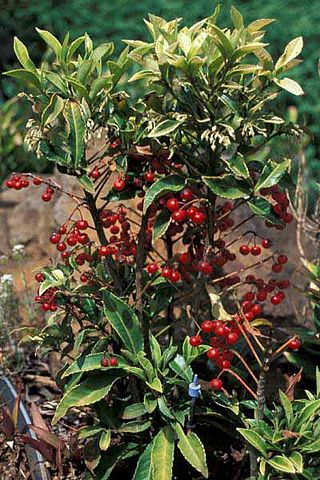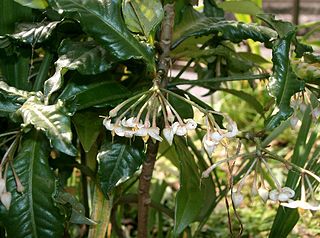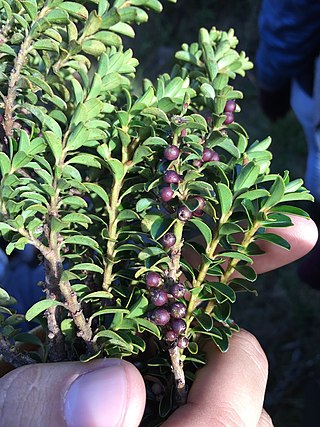
The Primulaceae, commonly known as the primrose family, are a family of herbaceous and woody flowering plants including some favourite garden plants and wildflowers. Most are perennial though some species, such as scarlet pimpernel, are annuals.

Cassia is a genus of flowering plants in the legume family, Fabaceae, and the subfamily Caesalpinioideae. Species are known commonly as cassias. Cassia is also the English common name of some species in the genus Cinnamomum of the family Lauraceae. Species of the genera Senna and Chamaecrista were previously included in Cassia. Cassia now generally includes the largest species of the legume subtribe Cassiinae, usually mid-sized trees.

Myrsinoideae is a subfamily of the family Primulaceae in the order Ericales. It was formerly recognized as the family Myrsinaceae, or the myrsine family, consisting of 35 genera and about 1000 species. It is widespread in temperate to tropical climates extending north to Europe, Siberia, Japan, Mexico, and Florida, and south to New Zealand, South America, and South Africa.

Conyza is a genus of flowering plants in the family Asteraceae.

Baccharis is a genus of perennials and shrubs in the aster family (Asteraceae). They are commonly known as baccharises but sometimes referred to as "brooms", because many members have small thin leaves resembling the true brooms. They are not at all related to these however, but belong to an entirely different lineage of eudicots. B. halimifolia is commonly known as "groundsel bush", however true groundsels are found in the genus Senecio.

Theophrastoideae is a small subfamily of flowering plants in the family Primulaceae. It was formerly recognized as a separate family Theophrastaceae. As previously circumscribed, the family consisted of eight genera and 95 species of trees or shrubs, native to tropical regions of the Americas.

Perrottetia is a genus of flowering plants in the family Dipentodontaceae described as a family in 1824. Species occur in China, Southeast Asia, Papuasia, Hawaii, Australia, and Latin America. It is the largest genus of the recently described order Huerteales.

Ardisia is a genus of flowering plants in the family Primulaceae. It was in the former Myrsinaceae family now recognised as the myrsine sub-family Myrsinoideae. They are distributed in the Americas, Asia, Australia, and the Pacific Islands, mainly in the tropics. There are over 700 accepted species. One species, Ardisia japonica is one of the 50 fundamental herbs in traditional Chinese medicine.
Geissanthus is a genus of shrubs and trees in the family Primulaceae. There are 51 species distributed in South America, with 25 of them in forests of the Andes.

Parathesis is a genus of flowering plants in the family Primulaceae. There are about 95 species distributed from Mexico to South America and the Caribbean. Plants of this genus can be distinguished by glandular papillae on the lobes of the flower corolla and bright yellow anthers.

Myrsine is a genus of flowering plants in the family Primulaceae. It was formerly placed in the family Myrsinaceae before this was merged into the Primulaceae. It is found nearly worldwide, primarily in tropical and subtropical areas. It contains about 200 species, including several notable radiations, such as the matipo of New Zealand and the kōlea of Hawaiʻi. In the United States, members of this genus are known as colicwood. Some species, especially M. africana, are grown as ornamental shrubs.

Carl Christian Mez was a German botanist and university professor. He is denoted by the author abbreviation Mez when citing a botanical name.

Embelia is a genus of climbing shrubs once placed in the family Myrsinaceae, which is now included in the Primulaceae. There are about 130 species which occur in tropical and subtropical areas across a wide range including Africa and Madagascar and from eastern Asia to the Pacific Islands as well as Australia including:
John James Pipoly III is an American botanist and plant collector. He is a leading expert on the systematics and taxonomy of the genus Ardisia within the Myrsinoideae, as well as the family Clusiaceae.
Clavija is a genus of flowering plants belonging to the family Primulaceae.
Ctenardisia is a genus of flowering plants belonging to the family Primulaceae.
Discocalyx is a genus of flowering plants belonging to the family Primulaceae.
Hymenandra is a genus of flowering plants belonging to the family Primulaceae.











